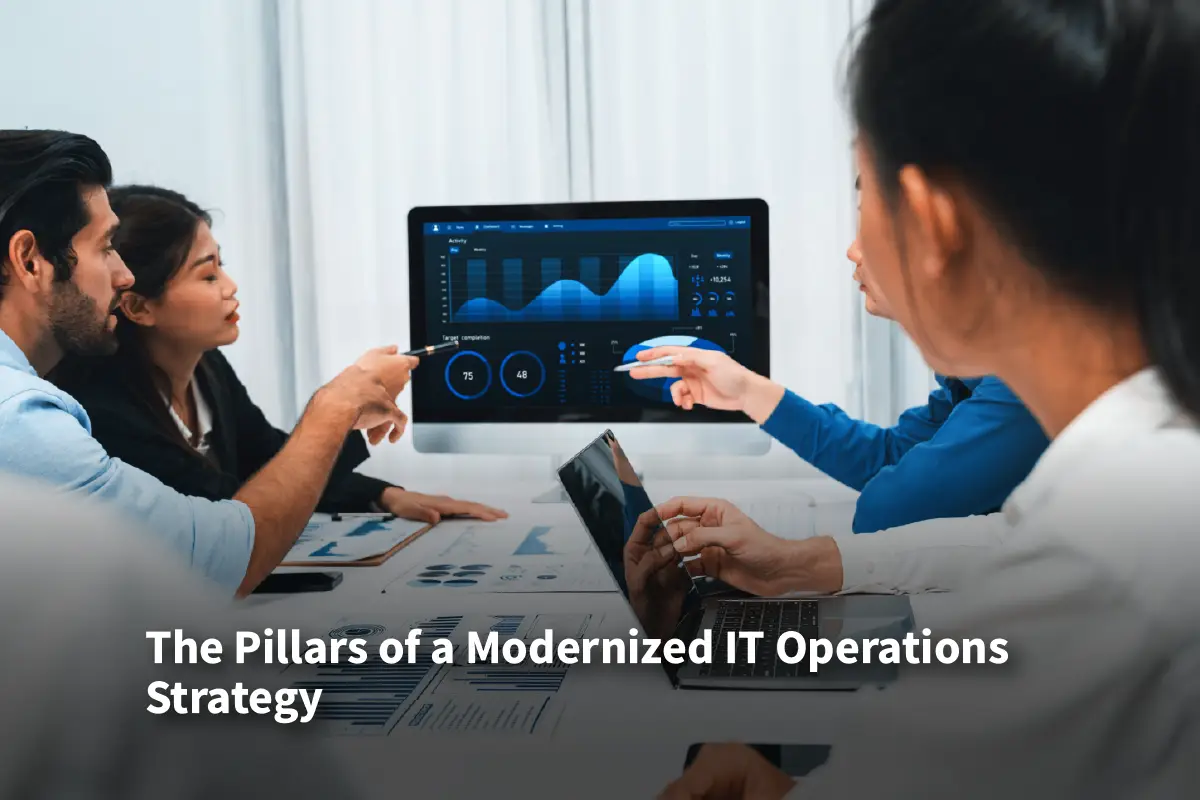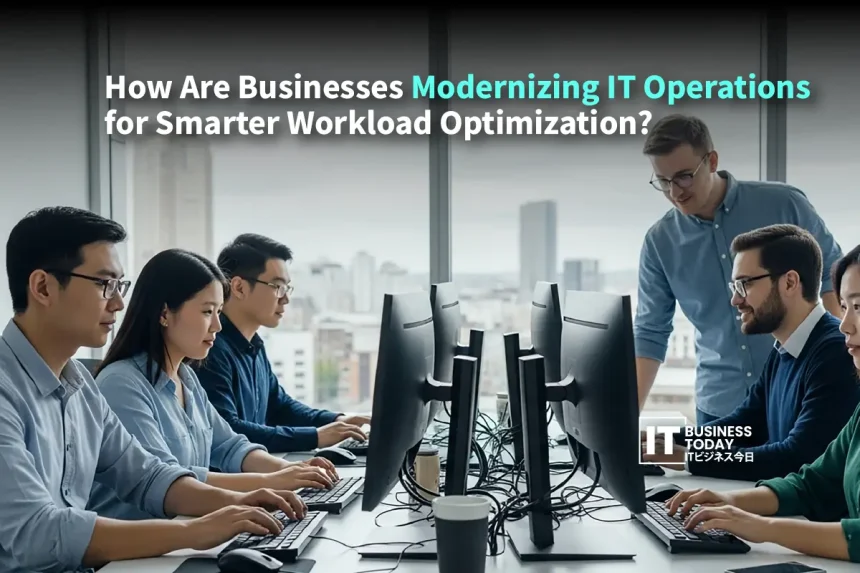何十年もの間 情報技術 オペレーションはシンプルでした。目標は稼働時間、指標は効率、そして王国はデータセンターでした。CIOとそのチームは、安定のための静かなヒーローでした。CIOとそのチームは、企業のデジタルの鼓動を安定させ、力強く保つために舞台裏で働いていました。しかし、その時代は取り返しのつかない形で終わりを告げました。デジタルトランスフォーメーションがすべてを変えたのです。古いプレイブックは古いだけではありません。
今日、ビジネスリーダーは自ら生み出したパラドックスに直面しています。クラウドエコシステム、ハイブリッド・ワークモデル、モノのインターネット、大規模データ分析など、俊敏性とイノベーションを約束したテクノロジーは、IT環境を非常に複雑なものにしています。ワークロードは、もはや整然とした一元的なパッケージではありません。今やワークロードはダイナミックに広がっています。ワークロードはパブリック・クラウドに分散しています、 プライベート データセンター、そしてエッジ。この複雑さは安定性を脅かすだけではありません。可視性を妨げ、コストを上昇させ、企業が必要とする俊敏性を制限します。もはや問題は、単に明かりを灯し続けることだけではありません。電力網全体をいかにスマートに管理するかということです。そうすることで、より優れたパフォーマンス、回復力、価値を確保することができるのです。 近代化 ITオペレーションは、ワークロードを最適化するために非常に重要です。これは今日のビジネスにとって極めて重要です。.
このシフトはITの役割を再定義します。ITは、ただ保守を行うコストセンターから、イノベーションを推進するバリューセンターへと変化します。手作業による消火活動から、プロアクティブでインテリジェントな自動オーケストレーションへの移行です。.
こちらもお読みください: 日本におけるデジタル治療:AIが変える精神医療の未来
近代化が譲れない理由
進化へのプレッシャーはあらゆる方向から押し寄せています。データの爆発的な増加がその主な要因です。企業はさまざまなソースから情報を入手します。このデータを処理・分析するワークロードは急速に増大しています。異なる時代に構築されたレガシー・システムでは、この負荷に対応できません。その結果、パフォーマンスが低下し、チャンスを失うことになります。.
さらに、競争環境では圧倒的なスピードが求められます。新しいアプリを立ち上げ、サービスを迅速に拡張し、ライバルよりも早く新しい市場に参入することは、際立った存在感を示すことにつながります。従来のIT調達と展開のサイクルは数カ月かかっていました。今日の市場では、これは大きな問題です。顧客は、クラウドネイティブのリーダーから迅速でシームレスなデジタル体験を望んでいます。スピードの必要性は、クラウドネイティブアーキテクチャの使用と密接に結びついています。マイクロサービス、コンテナ、サーバーレス機能は、アプリを多くのリンクされた部分に分割します。これは優れた柔軟性を提供しますが、同時に管理を厄介にします。手作業のツールや人だけで管理するのは不可能に近いのです。
最後に、収益に対する容赦ないプレッシャーがあります。ハイエンドのクラウドプラットフォーム上で必要でないアプリが動作すると、リソースの無駄遣いが発生します。また、使用されていない仮想マシンを放置することも問題に拍車をかけます。ある調査によると フレクセラ レポートでは、84%の企業がクラウド費用の管理がクラウドの最大の課題であると回答しています。 ストームフォージ の調査によると、クラウド費用のうち最大48%がアイドル状態または未使用のリソースで浪費されていることがわかりました。これは最適化が不十分なために起こります。資金流出は、真のイノベーションに利用できる金額に直接影響します。
近代化されたITオペレーション戦略の柱

IT運用の近代化とは、単にツールを変えることではありません。全体的な戦略です。IT運用の近代化は、単にツールを変更することではありません。これらの柱は、スマートで自己最適化可能なデジタルファブリックを形成します。.
基礎となる要素は包括的な観測可能性。見えないものを最適化することはできません。観測可能性は、従来のモニタリングを超えるものです。チームに障害を警告するだけでなく、システム全体の状態をリンクされた明確なビューで提供します。システムのあらゆる部分からメトリクス、ログ、トレースを収集します。 ハイブリッド 環境を提供します。そして、強力なアナリティクスを使用してコンテキストを与え、ビジネスに影響を与える前に問題の根本原因を見つけます。これが現代のITオペレーションの中枢神経系です。しかし 10% の組織が、アプリケーションとインフラストラクチャ全体で完全な観測可能性を達成しています。
インテリジェント 自動化 と人工知能はこの基盤の上に成り立っています。これが最適化のエンジンです。AIOps、つまり ITオペレーション機械学習を使用。観測ツールによって収集された大量の遠隔測定データを分析します。パターンを発見し、停止を予測し、自動的に修正を開始することができます。これは多くの場合、人間が問題に気づく前に行われます。これにより、チームの焦点は、平凡な反復作業から戦略的イニシアチブへとシフトします。自動化はルーチン・タスクを処理します。インテリジェンスは意思決定に役立ちます。ワークロードの予算に合わせて最適なインフラを表示します。また、需要に合わせてリソースを自動的に拡張します。グローバル エーアイオプス 2024年の市場規模は18億7,000万米ドルで、2032年には86億4,000万米ドルに成長すると予測されています。
この構造全体は、DevOpsとFinOpsの原則が文化的に受け入れられるかどうかにかかっています。DevOpsは開発と運用の間の障壁を取り除きます。アプリケーションのライフサイクル全体に責任を持つことを全員に求めます。この文化的転換が鍵です。これは、今日必要なスピードと信頼性を実現するのに役立ちます。FinOpsは、クラウド支出の財務責任モデルを追加します。これにより、技術チーム、財務、ビジネスリーダーが一体となります。こうすることで、リソースの使用方法について、データに基づいた意思決定を共同で行うことができます。最適化は技術的な目標であると同時にビジネス上の目標でもあります。ITパフォーマンスを財務結果に直結させます。
目に見えるメリット
最新のIT運用への投資は、組織全体に利益をもたらします。最も直接的な効果は、通常、運用コストの大幅な削減です。リソースの適正化、無駄の削減、タスクの自動化により、企業は数百万ドルを節約できます。この節約分を成長イニシアチブに充てることができます。
回復力と信頼性も同様に重要な成果です。1時間のダウンタイムが数百万ドルのコストと評判を損なう可能性がある世界では、最新のITスタックには予測機能と自己回復機能が必要です。企業は、優れた顧客体験を確保することができます。また、突発的なサージやコンポーネントの故障が発生した場合でも、スムーズな稼働を維持することができます。
主な利点は、イノベーションのスピードアップです。開発者は、セルフサービス・プラットフォーム、自動デプロイメント・パイプライン、安定したインフラストラクチャを利用して、迅速に作業を進めることができます。このアクセスにより、開発者は実験、反復、新機能の立ち上げをこれまで以上に迅速に行うことができます。この俊敏性により、ITはボトルネックから触媒に変わります。ビジネス全体がピボットし、新たな機会に適応できるようになります。
行動のための青写真

この旅に出るリーダーにとって、その道は評価から始まります。既存の資産を徹底的に監査しましょう。アプリとその依存関係をマッピングします。そして、現在のクラウドとデータセンターの支出をチェックします。これにより、コストを最適化する明確な方法を見つけることができます。ターゲットを絞ったパイロット・プロジェクトから始めましょう。観測可能なプラットフォームとして、特定のアプリケーションまたはビジネス・ユニットを選択します。その後、自動化を追加します。これを概念実証として利用し、価値を実証して機運を高めます。
重要なのは、人材への投資です。テクノロジーは、それを操るチームがあって初めて効果を発揮します。クラウドアーキテクチャ、データ分析、自動化スクリプトについてITチームをトレーニングしてください。継続的な学習とコラボレーションの文化を醸成しましょう。最後に、ベンダーだけでなく、テクノロジー・パートナーを選びましょう。オープンで統合されたエコシステムを持つプラットフォームを選びましょう。パートナーは、お客様のニーズに応じて成長する必要があります。そうすれば、新たなサイロ化を避けることができます。
ITオペレーションの近代化は静かな革命です。それは世界のトップ企業で起こっています。それは、問題を解決することから先の計画を立てることへのシフトです。ITはコストセンターからイノベーションのエンジンへ。グローバル・ビジネスのリーダーたちは、次のようなメッセージを受け取っています。 ワークロード そして全体的なオペレーションのインテリジェンス。目標はもはや安定したインフラストラクチャではなく、よりスマートなビジネスです。







